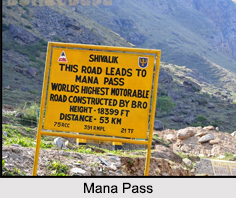 Situated at an elevation of 5,632 m, the Mana Pass is known to be one of the highest vehicle accessible mountain passes in the world. The Mana Pass is located in the Himalayas on the border between India and Tibet. The road connecting the countries of India and Tibet was constructed in a period from 2005 to 2010 by the Border Roads Organisation for the Indian military. This well graded gravel dirt road is higher on the Indian side than the new road on the Tibetan side.
Situated at an elevation of 5,632 m, the Mana Pass is known to be one of the highest vehicle accessible mountain passes in the world. The Mana Pass is located in the Himalayas on the border between India and Tibet. The road connecting the countries of India and Tibet was constructed in a period from 2005 to 2010 by the Border Roads Organisation for the Indian military. This well graded gravel dirt road is higher on the Indian side than the new road on the Tibetan side.
Geography of Mana Pass
The Mana Pass is located within the Nanda Devi Biosphere Reserve, which lies 24 km north of the town of Mana, and 27 km north of the Hindu pilgrimage town of Badrinath in the Indian state of Uttarakhand. Mana is a small village in Chamoli District of Uttarakhand. The village of pristine beauty is located at an altitude of 3,200 meters and is on the northern terminus of National Highway 58.
The Nanda Devi Biosphere Reserve is the source of the Saraswati River, one of the tributary of Ganga River and the Alaknanda River. Saraswati River trickles through the several small ponds between the Mana Pass and Lake Deo Tal, which is 3 km from the southwest of the mountain pass. The Mana Pass also acts as a key road for climbing Chaukhamba peak.
History of Mana Pass
Once an ancient trade route between Uttarakhand and Tibet, the Mana Pass led from Badrinath to the present province of Guge in Tibet. In 1624, two Portuguese Jesuits named Antonio de Andrade and Manuel Marques became the first known Europeans to enter across Mana Pass. Until its closure in 1951 by the Chinese, the Mana Pass was used as a minor trade route. The ban on the mountain pass was lifted on 29th April, 1954, when China and India signed an agreement granting pilgrims and indigenous travellers the right to travel between the two countries through Mana Pass.
Visiting Information on Mana Pass
The Mana Pass can be reached from the south by an extension of National Highway 58 that connects Delhi with Badrinath.



















